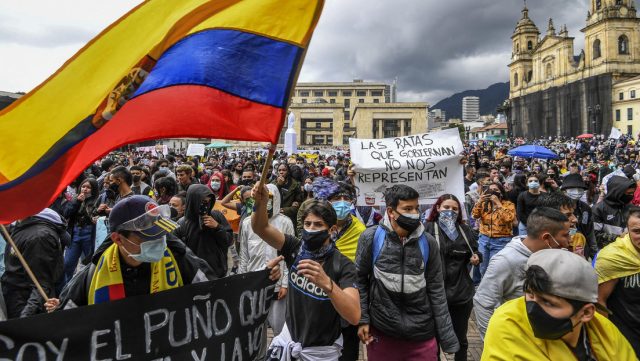The protests return to the streets. This time it is to commemorate the first anniversary of the anti-government mobilizations in Colombia, known as ‘the national strike’, which put the allegations of human rights violations by riot police under international scrutiny.
A year later there is no conclusive figure on the number of deaths between April and June 2021, the period with the highest number of mobilizations. The official version says that there were 29, but the NGOs point to 80 people murdered in that context, explains the journalist Nathali Gómez for RT.
Several social, student, peasant, indigenous and union organizations announced that from April 28 to May 1 they will carry out 60 activities that include concentrations, demonstrations, cultural and environmental events in the cities of Bogotá, Medellín, Bucaramanga, Popayán and Cali, the capital of the department of ‘Valle del Cauca’, which was the epicenter of popular discontent and police repression during the national strike.
Prior to these demonstrations, disturbances were reported at the National University of Bogotá. According to a statement from the institution’s authorities, 30 men, from an armed group, entered the university and took over a classroom building by force and manipulated explosives. Following these events, four people were injured.
The so-called social outbreak of 2021 began in April of that year as a protest against a failed tax reform promoted by the Government of Iván Duque, which left as a balance the paralysis of the project and the departure of the Minister of Finance, Alberto Carrasquilla.
These mobilizations gave rise to the demand for the fulfillment of other demands such as free access to public university education, the creation of a monthly basic income for millions of families affected by the economic crisis generated by the pandemic and the integral presence of the State in the regions where illegal armed groups operate.
Colombia n police take to the streets
As it happened a year ago, the Government, which for days has maintained that it has information on possible «infiltrators», has announced a large deployment of uniformed personnel.
Throughout the country, there will be 50,000 uniformed personnel destined to «attend to the planned mobilizations and concentrations», reported the director of the Police, Luis Vargas Valencia, on Wednesday night from the Unified Command Post. In Bogotá alone there will be 4,000 officials on the streets, among whom are members of the questioned Mobile Anti-riot Squad (ESMAD), the Judicial and Criminal Investigation Sections (SIJIN), the Police Intelligence Directorate (CIPOL), among other specialized security agencies.
Vargas Valencia asserted that they handle information that in twelve cities of the country, in more than 25 points, there are «people who want to generate crimes such as attacks on the Police, public servants, and to institutional properties». Similarly, he stated that they were aware that the National Liberation Army (ELN) and the dissidents of the Revolutionary Armed Forces of Colombia (FARC) «want to generate disturbances and violence».
Meanwhile, the director of the Bogotá Police, Eliecer Camacho, published an open letter on his Twitter account calling on the protesters to carry out the activities «peacefully» and to avoid «events that lead to vandalism». In the text he says that the police «is committed to caring for the citizens and groups that will march».
One year after the national strike, the possibility of the so-called stigmatization of the protest reappears, denounced by the social and the defense of human rights organizations, which blamed government spokesmen for justifying the repression and excessive use of force against the protesters. Among his arguments, the alleged unproven presence of groups of infiltrators with international financing who sought to destabilize the Government.
Hours before the mobilizations this Thursday, the Minister of the Interior, Daniel Palacios, warned that social protest will be guaranteed but that they handle information about groups “that promote vandalism” and that could generate violence.
Human rights
The performance of the security forces in containing the demonstrations was the main issue during the 2021 protests.
Days before a working visit by the Inter-American Court of Human Rights (IACHR), carried out last June to investigate the complaints about the excessive use of force by the uniformed officers, the Colombian president announced a police «transformation» and the «modernization» of the Ministry of Defence. The opposition and social organizations called this measure «cosmetic» since it did not address the underlying problem generated by social inequality and the limited presence of the State in the territories of the conflict.
The guarantee of respect for human rights by the Public Force was also under international scrutiny. In December 2021, the United Nations Organization (UN) issued a document, entitled ‘The National Strike 2021: Lessons Learned for the exercise of the right to peaceful assembly in Colombia’, where it refers to the figure of 63 deaths in the context of protests. Of that number, 46 cases were verified, of which 28 would be homicides at the hands of the public force, 10 would have been committed by «non-State actors» and in eight cases it was not possible to obtain sufficient data.
Colombian NGOs –such as the Institute of Studies for Development and Peace (Indepaz) and Temblores– manage a total figure of 80 deaths related to the demonstrations, in addition to eye injuries, sexual violence, forced disappearances, arbitrary detentions and verbal and physical attacks.
Regarding the data on deaths, there is a wide margin of discrepancy. Until now, the Prosecutor’s Office has announced that there were 29 homicides that would be related to the protests and that 4,269 complaints were received, of which 4,009 are under preliminary inquiries, 57 under investigation, 179 on trial, 123 in execution of sentences and one in early termination. In addition, 606 arrests were made, 625 people were charged and there are convictions against 30 people, reports El Tiempo.
Regarding the people reported as missing, the Prosecutor’s Office reported that they received 627 reports of this type of situation and specified that 295 people were located; 132 were duplicate records; 192 were inadmissible and 8 have not been located.



